POLYGON INSCRIBED IN A CIRCLE
If all of the vertices of a polygon lie on a
circle, the polygon is inscribed in the circle and the circle is circumscribed
about the polygon. The polygon is an inscribed polygon and the circle is
a circumscribed circle.
Theorems About Inscribed Polygons
Theorem 1 :
If a right triangle is inscribed in a circle, then the hypotenuse is a diameter of the circle. Conversely, if one side of an inscribed triangle is a diameter of the circle, then the triangle is a right triangle and the angle opposite the diameter is the right angle.
It is illustrated in the diagram shown below.
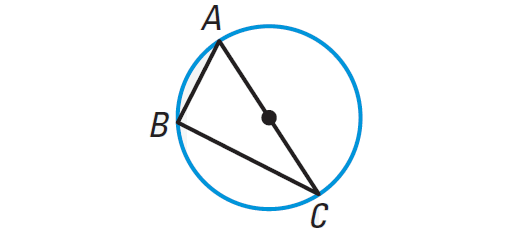
In the diagram shown above, ∠B is a right angle if and only if AC is a diameter of the circle.
Theorem 2 :
A quadrilateral can be inscribed in a circle if and only if its opposite angles are supplementary.
It is illustrated in the diagram shown below.
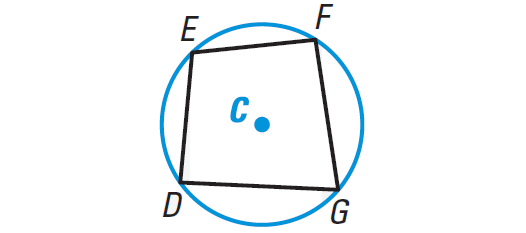
In the diagram shown above, D, E, F, and G lie on some circle with center at C, if and only if
m∠D + m∠F = 180° and m∠E + m∠G = 180°
Using Theorems 1 and 2
Example 1 :
Find the value of x in the diagram shown below.
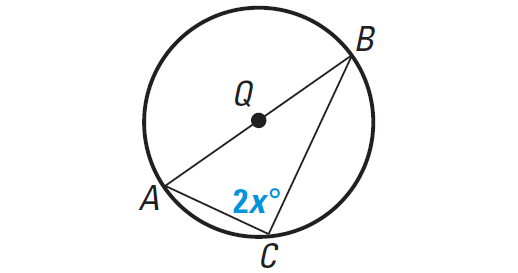
Solution :
AB is diameter. So, ∠C is a right angle and m∠C = 90°.
2x° = 90°
2x = 90
Divide each side by 2.
2x/2 = 90/2
x = 45
Example 2 :
Find the value of y and z in the diagram shown below.
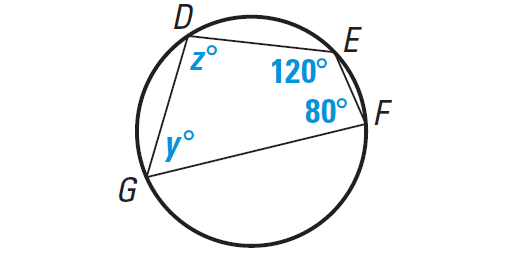
Solution :
DEFG is inscribed in a circle, so opposite angles are supplementary.
|
m∠E + m∠G = 180° 120 + y = 180 z = 60 |
m∠D + m∠F = 180° z + 80 = 180 z = 100 |
Using an Inscribed Quadrilateral
Example 3 :
In the diagram, polygon ABCD is inscribed in the circle with center P. Find the measure of each angle.
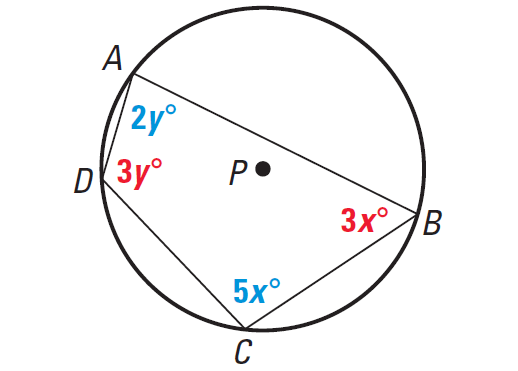
Solution :
ABCD is inscribed in a circle, so opposite angles are supplementary.
So, we have
3x + 3y = 180 -----(1)
5x + 2y = 180 -----(2)
To solve the above system of linear equations, we can solve the first equation for y.
(1)-----> 3x + 3y = 180
3(x + y) = 180
Divide each side by 3.
3(x + y) / 3 = 180 / 3
x + y = 60
Subtract x from each side.
y = 60 - x -----(3)
Plug y = 60 - x in the second equation.
(2)-----> 5x + 2(60 - x) = 180
5x + 120 - 2x = 180
Simplify.
3x + 120 = 180
Subtract 120 from each side.
3x = 60
Divide each side by 3.
3x / 3 = 60 / 3
x = 20
Plug x = 20 in the third equation.
(3)-----> y = 60 - 20
y = 40
We get x = 20 and y = 40.
So, we have
m∠A = 2y° = 2(40°) = 80°
m∠B = 3x° = 3(20°) = 60°
m∠C = 5x° = 5(20°) = 100°
m∠D = 3y° = 3(40°) = 120°
Kindly mail your feedback to v4formath@gmail.com
We always appreciate your feedback.
©All rights reserved. onlinemath4all.com
Recent Articles
-
Trigonometry Even and Odd Iidentities
May 05, 24 12:25 AM
Trigonometry Even and Odd Iidentities -
SOHCAHTOA Worksheet
May 03, 24 08:50 PM
SOHCAHTOA Worksheet -
Trigonometry Pythagorean Identities
May 02, 24 11:43 PM
Trigonometry Pythagorean Identities

